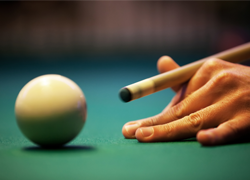 In my early 20’s I was working with a salesman who was a semi-professional snooker player, we got onto the subject of snooker and he told me that if we spent approx. three hours of playing together he could drastically alter my whole game and make me a much better player. He reckoned that under his guidance I’d quickly move on from making breaks of 20’s, on a very haphazard fashion like an American pool player, to having a completely different approach to the game. Within three hours he’d alter my whole game in order that I could begin to think of regularly making breaks of 30+, they would no longer be my best, they’d be the norm. And he was right…
In my early 20’s I was working with a salesman who was a semi-professional snooker player, we got onto the subject of snooker and he told me that if we spent approx. three hours of playing together he could drastically alter my whole game and make me a much better player. He reckoned that under his guidance I’d quickly move on from making breaks of 20’s, on a very haphazard fashion like an American pool player, to having a completely different approach to the game. Within three hours he’d alter my whole game in order that I could begin to think of regularly making breaks of 30+, they would no longer be my best, they’d be the norm. And he was right…
During the very first session he’d altered my stance, how I held the snooker cue, how I was striking the ball, where I should focus my eyesight, how to exercise control of the cue ball, even my breathing was changed, how I ‘chalked’ the cue and crucially he slowed me down. He taught me how I could ‘plot’ my moves with the cue ball similar to thinking moves ahead in chess. By lesson three I was unrecognizable from the player I was. Whisper it quietly, but I actually looked quite professional in my overall approach to the game. Three hours of tutoring by someone who knew what he was doing had completely reinvented me as an amateur player.
I often think of this steep learning curve in relation to new FX traders and how someone with greater skills could very quickly alter the many bad habits that affect their ‘game.’ And the good news is that its so easy to correct the main mistakes.
I’ve provided a short five/six key point list here and we’d be delighted if our community would like to join us and offer up some opinion on what immediate improvements could be made to up a ‘trader’s game’ in order to make them look and act professional from their very next trading session, or what improvements they have already made.
Slow down the whole process
Trading of a one hour time frame? Then move up to 4hr, 8hr or daily; trade less earn more. You can’t possibly trade in the virtual ‘HFT pit’, so don’t even contemplate trading on short term time frames, you’ll get killed by spreads, commissions and slippage. And a potential slippage can ruin the good day you’ve had with just one rogue trade if the liquidity suddenly disappears, or you get caught by a random high impact news event.
Always seek a bigger gain than the risk you’re taking per trade.
There are many reports available from brokers that illustrate that the losing pip loss on losing trades outweighs the winning pips on winning trades by some margin. That losing versus winning actually has a quite dramatic affect on your P&L. For every winning trade gain of 60 pips the losing trade loss is circa 120 pips. Traders fail to cut losses early enough and fail to let winners run. Therefore if you’re exercising a 50:50 win ratio based on a 1:1 R:R you’ll lose money. It might look like break-even but when you consider the spread, the commission and perhaps the occasional slippage you’ll come up short. Therefore you might want to increase your win loss ratio, hopefully to 55:45 and increase your pip gain target to greater than 1:1.
Lack of trading plan
We often repeat this basic element, but it really can’t be stressed enough, act like a professional, plan everything. The securities you’re going to trade, the risk per trade, set targets, set drawdowns, set the maximum number of trades you’ll take per day perhaps limit your trading to certain times of the day.
Lack of capitalisation
You will not turn €1000 euros into €10,000, so never be seduced by system sellers on forums or through the pop ups you’ll experience through your browser if you’re constantly searching trading related issues. If you’re aiming for a reasonable return set a target of 50-100% account growth in your first profitable year.
Impatience
This directly relates to your trading plan. It’s incredibly important that you exercise patience and only take the set ups identified through your trading plan, set ups conforming with your edge. And as we’ve stressed in other articles probabilities plays a huge part in a traders life and returns, therefore take all the set ups, don’t let gut feeling or hesitancy stand in your way.
Greed
If you’ve decided to only risk 1-2% of your account per trade stick with that ratio. The trader’s world is full of stories of guys who got carried away by their early success to up their risk from 2% to 5% then 10% per trade to suffer a series of four losses to lose 40% of their account. For most this is an irrecoverable situation brought on by greed.





